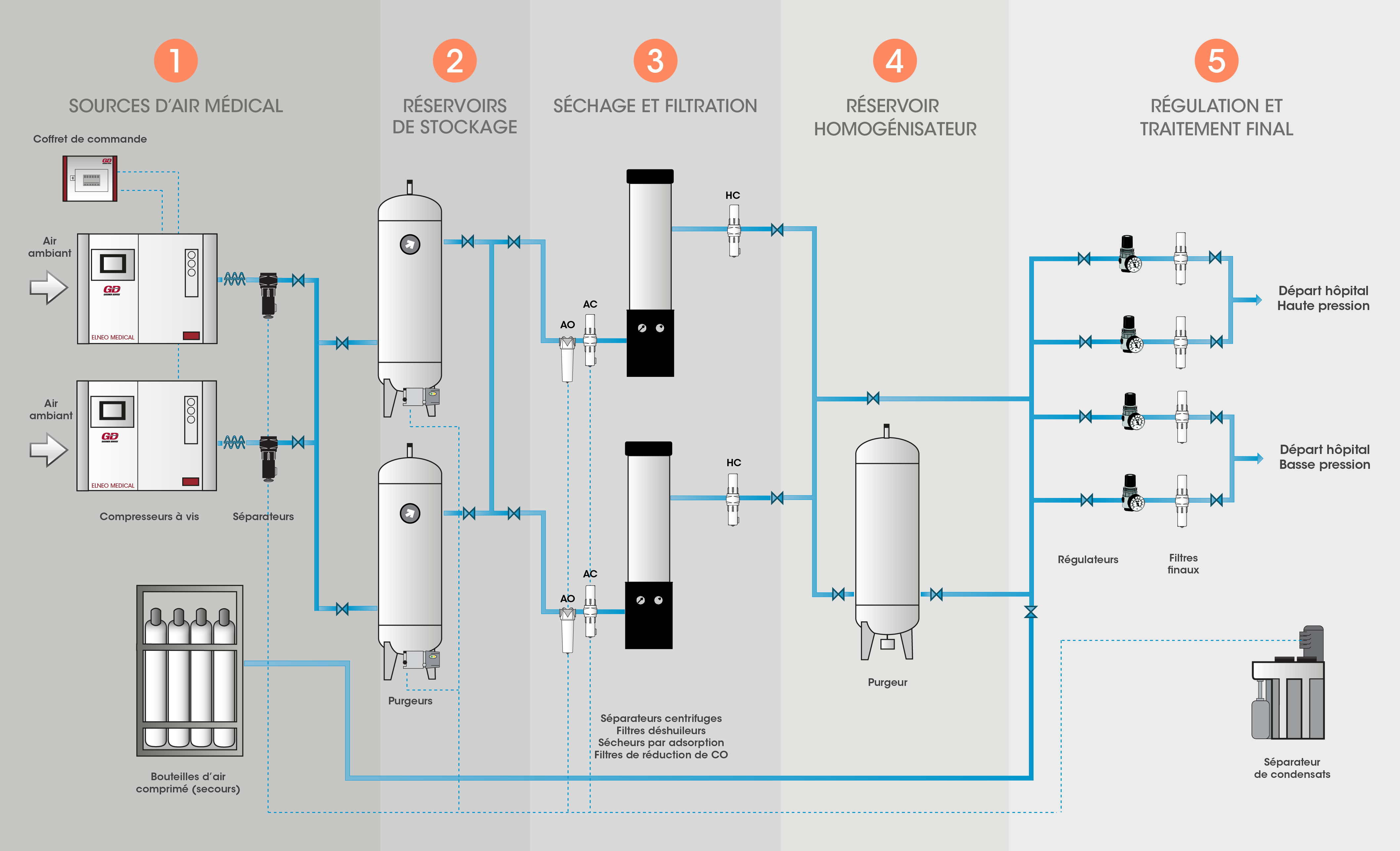Compliance requirements
Compliance requirements for medical air and vacuum installations
The production of medical air and vacuum are class IIa medical devices. In order to guarantee a high level of safety and performance, these installations must meet the requirements of the 2017/745 regulation. Elneo has started the certification process according to this new regulation in 2022.
ISO-EN7396-1 is the worldwide reference for medical gas installations. This standard defines the equipment and assembly requirements.
Medicinal air, the norm imposes :
- 3 separate sources (each capable of providing the hospital's design flow and pressure)
- A source is a compressor, a cylinder rack or a synthetic air production system.
- Elneo recommends the installation of 3 compressors or 2 compressors supplemented by a backup cylinder rack.
- 2 buffer tanks.
- 2 compressed air treatment lines, each comprising a filter battery and a dryer.
- Each line must be capable of handling the design throughput.
- The quality of the air supplied must comply with the European Pharmacopoeia in force.
- A monitoring and alarm system.
- A system for displaying the humidity and CO content of the compressed air.
It is forbidden to use medicinal air for other than medical applications (no technical use).
Medical vacuum, the standard imposes:
- 3 separate sources (each capable of providing the hospital's design flow). A source usually has one or more vacuum pumps.
- A buffer tank.
- A system of bacteriological filters connected in parallel.
- A monitoring and alarm system.
- An automatic control system.
- Pump exhausts should be evacuated outside and well away from compressor suctions, doors and/or other building openings.
- The installation must be carried out and certified "CE-medical" by an approved company (except if the installation is carried out by the hospital itself).
- The installation must be connected to an emergency power source.
- The air and vacuum rooms must be specifically reserved for this purpose.
- The technical staff must be specifically trained.
- The pharmacist in charge of the hospital is also responsible for the production of air and vacuum for medical use.
MEDICINAL AIR PRODUCTION PLANT

1. MEDICINAL SOURCES
Elneo, exclusive Gardner Denver distributor, offers a wide range of compressors to meet all the usual requirements in the hospital environment.
Lubricated screw compressors are the most classic and most widely used compressors in the medical field. They combine reliability, performance and low noise level.
They thus best meet the needs of hospitals. These compressors are available in fixed and variable speed versions and are equipped with electronic control cabinets with communication interface. As an option, heat recovery for hot water production is available as standard.
|
Depending on the customer's choice, we offer completely oil-free, water-injected compressors. These machines have a higher efficiency thanks to a compression close to the isotherm and are available with variable speed control.
|
|
|
The GD-CONNECT 12 control system manages the operation of medical compressed air systems. It manages the periodic changeover of the compressors, the operation at a constant pressure level and monitors all compressor alarms. In addition, dew point and pressure level alarms are fully supported.
All operating data are permanently stored on a memory card and can be transmitted via common protocols or via web server to a central management system.
2. STORAGE TANKS
The ISO/EN7396-1 standard provides for 2 compressed air receivers as soon as the installation consists of at least 2 compressors. Our tanks are, unless otherwise specified, delivered in an internal and external galvanized finish, equipped with a safety valve with calibration certificate, pressure gauge and automatic air vent. All our tanks comply with the European standards in force.
3. MEDICINAL COMPRESSED AIR TREATMENT
The most important link in the chain downstream of the compressor is the compressed air treatment system. This system must consist of two independent treatment lines, each capable of handling the hospital's design flow rate.
Each processing line is composed as follows:
- Pre-filtration :
- coalescing filter: mechanical pre-filtration 1 micron and residual oil content: 0.6 mg/m³ max.
- deodorizing oil filter: maximum residual oil content at 21°C: 0.003 mg/m³
- Adsorption dryer: pressure dew point down to -70°C. Dryer equipped with NO valves: in case of power failure, the air will continue to flow through the dryer.
- Downstream filtration: catalyst filter transforming CO into CO².
At the exit, the air will be at least of the quality required by the European Pharmacopoeia, namely :
Our treatment lines are designed to obtain an air quality superior to the requirements of the European Pharmacopoeia. It is important to point out that, whatever the type of compressor (lubricated or not), the same treatment chain will have to be installed. Indeed, no one can guarantee the quality of the air sucked in by the compressor. The air sucked in always contains a number of impurities well above the limits set by the European Pharmacopoeia.
4. HOMOGENIZING TANK
At the exit of the treatment lines, depending on the load conditions of the dryers, short variations in oxygen and carbon dioxide content can be detected. In order to keep the air quality constant, we install a homogenizing tank at the exit of the filtration lines, in order to dilute the O² and CO² "peaks" in a volume of air.
5. REGULATION AND FINAL TREATMENT
At the outlet of the homogenizer tank, the medicinal compressed air is ready to be distributed to the hospital network. Usually there are 2 networks, one with 10 barg and one with 5 barg, and a set of 2x2 regulators will regulate the 2 pressures. Redundancy (safety) is ensured by doubling the components.
Following the pressure regulators, we provide safety filters, supplied with test certificate. These filters ensure that no particles larger than 0.01 μm enter the medicinal air network. Virtually at the outlet point of these filters, the air can be considered sterile.
CONDENSATE TREATMENT
After compression and cooling, compressed air contains a large volume of condensate. These are eliminated by automatic drains placed at the outlet of the compressors, under the tanks and under the filters placed before the dryers. Elneo usually installs level-sensing drains.
Since the condensate produced cannot be discharged as such to the sewer, it is treated by a water/oil separator.
MEDICAL VACUUM PRODUCTION PLANT
Vacuum is a strategic fluid in the health sector because there is no such thing as bottle rescue. For this reason, our systems are designed to ensure maximum safety and comply with the requirements of the MDD 93/42 directive. We offer a wide range of vacuum units composed of 3 to 6 pumps that meet the requirements of the ISO 7396/1 standard and the English standard HTM 02/01.
MEDICAL VACUUM GENERATION SYSTEM
We offer HOSPIVAC sets. These are supplied certified and ready for connection. The most common equipment consists of a rack with 3 (or more) pumps, the management automaton, the double anti-bacterial filtration unit and a buffer tank. Alternatively, if the intended location does not allow the installation of the rack, the equipment is supplied separately for placement on the ground. Smaller units can be delivered directly mounted on the buffer tank.
REGULATION OF THE PRODUCTION SYSTEM
CYCLIC 2020J
PROCOM 2
MAVO Emergency Trolley
3 fluids: Air, Vacuum, Oxygen
Ultimate back-up system to guarantee the supply of medical fluids to certain hospital departments (such as operating theatres, intensive care units, etc.) in the event of a malfunction in the main supply network in order to complete operations in progress.
- Mobile emergency cart intended for the distribution of fluids :
- Medical vacuum with a dry piston vacuum pump type PS12V
- 2 standard sockets on the right side of the display panel + 2 specific hoses
- Medical oxygen with 1 mobile oxygen cylinder
- 1 standard socket on the right side of the display panel + 1 specific pipe
- Medical air with a mobile air cylinder
- 1 standard socket on the right side of the panel + 1 specific pipe
- Functional and reliable device for the hospital team
- A dry piston vacuum pump used for safe operation with the presence of oxygen
- The PROCOM2 monitoring system is integrated into the emergency mobile cart.
- Bottles are not provided
Ultimate system to guarantee the medical fluid supply for different medical departments (surgery, intensive care..) in case of failure of the main supply, to complete the ongoing operations.
|
Oxygen level : |
20.4 - 21.4% |
|
Carbon dioxide (CO²) : |
< 500 ppmv |
|
Carbon monoxide (CO): |
< 5 ppmv |
|
Sulfur dioxide (SO²): |
< 1 ppmv |
|
Oil : |
< 0.1 mg/m³ |
|
Nitrogen oxides (NOX): |
< 2 ppmv |
|
Water : |
< 67 ppmv |
The Cyclic regulation is designed on the basis of a PLC for the control and monitoring of 3 vacuum pumps. It also allows the control of the room ventilation. A simple interface allows to visualize the main parameters and alarms. The Cyclic cabinet has a JBUS interface for communication with an external centralized management system.
Procom 2 control is more advanced. An automaton manages 2 to 6 pumps. A large color touch screen and a simple interface allow to visualize all parameters and alarm history. A modbus interface (on RS485) allows the connection with external centralized management systems. An ethernet link is also available and the cabinet can be connected to the VIGIMIL'S control unit for remote monitoring.
Features
|
|||||||||||||||||||

